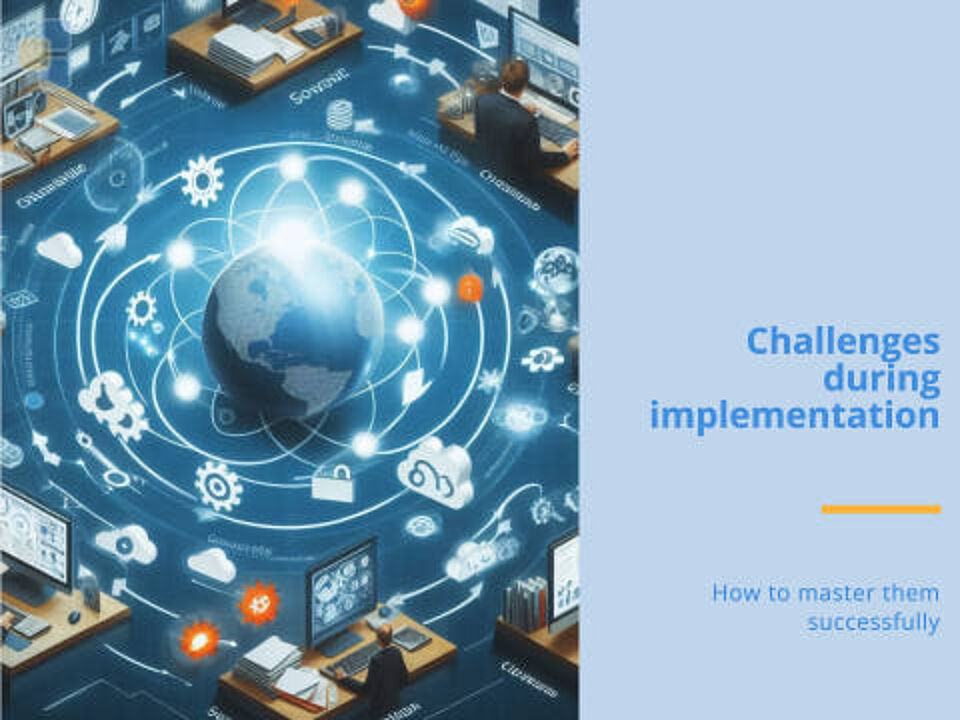
Author: Ralph Bockisch
created on: 27.05.2025, last change: 05.06.2025
Table of contents
Why rights management in ITSM is more than just a technical detail
Role model in EcholoN - flexible, secure, scalable
Best practices and tips for introducing effective rights management
Successful implementation of rights management in companies
Challenges during implementation - and how to master them successfully
Frequently asked questions about rights management in ITSM
Why rights management in ITSM is more than just a technical detail
Effective rights management (DRM) is no longer a nice-to-have feature, but a key requirement for security, efficiency and control in IT. In IT service management (ITSM) in particular, it is important that access rights are clearly defined and implemented consistently across departments, locations and hierarchical levels.
Because: Only those who have access to the right information and functions can perform their tasks efficiently – without compromising data protection or process integrity. A structured role model ensures that responsibilities remain traceable and security gaps are closed. For organisations with complex structures, this means transparent IT processes, clear responsibilities and greater compliance and trust.
What is rights management in ITSM? – Definition, objectives and challenges
At its core, rights management, as part of identity management, means controlling access to information, functions, processes, assets and IT infrastructure within an ITSM solution. It defines who is allowed to do what, when and how, based on roles, responsibilities and requirements within the company.
In the context of IT service management, rights management not only serves security purposes, but also ensures efficiency and traceability of processes. It protects sensitive data from unauthorised access, helps to comply with regulatory requirements (e.g. ISMS, GDPR, ISO 27001) and ensures that employees only see and use the functions they need for their work. In ITIL, the topic of rights management also plays a major role and is primarily regulated in access management.
Many classic tools reach their limits here:
- Rigidly defined role models often cannot be adapted to individual company structures.
- Manual rights assignment is error-prone and time-consuming.
- A lack of transparency makes traceability difficult during audits.
Modern ITSM systems such as EcholoN therefore rely on flexible, finely adjustable rights models that grow with the requirements of the organisation – instead of restricting them.

Role model in EcholoN - flexible, secure, scalable
EcholoN offers rights management that adapts precisely to your organisational structure – regardless of whether you are a medium-sized company or an international corporation. The role-based model allows fine-grained control of user rights without becoming overly complex.
What makes the EcholoN role model so practical?
- Individual rights assignment at the level of processes, fields, masks and actions
- Access control via roles and groups that precisely reflect how your teams are organised
- Connection to existing directories such as LDAP, Active Directory, Azure AD (Entra ID) for automated user and rights management
- Multi-client management for organisations with multiple locations or subsidiaries
- Logical and physical client separation for increased security for roles and permissions
Real-world example:
A company uses EcholoN to define different rights for IT, human resources, maintenance and quality management. While the IT department has full access to all tickets and system data, HR only sees personnel-related requests – thanks to hybrid and intelligent access control on a single platform.
The result is a rights management system that combines scalability with security – and reduces the workload for administrators and specialist departments alike.
Advantages for companies and administrators – control, transparency and security
Well-designed rights management with EcholoN brings tangible benefits on several levels – especially for administrators, data protection officers and decision-makers who value efficiency, compliance and security.
Your advantages at a glance:
- More control: Roles and rights can be managed centrally and flexibly adapted as required – even for new employees or changed responsibilities.
- Greater security: Only authorised users have access to sensitive data and functions – this reduces security risks and meets compliance requirements.
- Audit security: Every right assigned is transparently documented and can be traced without gaps – a real advantage during audits or certifications.
- Efficiency in IT operations: Automated processes such as rights inheritance, group assignment and directory integration save administrators valuable time.
- Scalability: The role model grows with your organisation – regardless of whether new teams are added or existing structures change.
In short: EcholoN not only makes rights management more secure, but also easier – making it a real success factor for your IT organisation.

Best practices and tips for introducing effective rights management
Effective rights management does not happen overnight – it is based on clear structures, careful planning and continuous maintenance. With these best practices, you can lay the foundation for a permanently stable and transparent role model in your ITSM system:
- Plan roles centrally: Before assigning rights, define clear role profiles. Who needs which access rights – and why? Early coordination with specialist departments prevents corrective loops later on.
- Document access rights: Record which roles exist, what rights they include and who they are assigned to. This creates transparency and avoids redundant authorisations.
- Maintain a rights matrix: A regularly updated rights matrix helps you maintain an overview – especially in complex structures with changing responsibilities.
- Use directory services: Integrate systems such as Active Directory or Entra ID to automate user and rights management and reduce sources of error.
- Conduct training: Effective rights management stands and falls with its application. Raise awareness among your employees about how to handle permissions and processes.
- Check regularly: Schedule permission reviews at fixed intervals to identify and remove outdated or unnecessary rights – this increases security and saves resources.
With these measures, you can create a rights management system that not only works, but also builds trust among users, auditors and IT managers alike.
Rights management in the context of data protection and IT security
In the digital environment, data protection and IT security are at the top of the agenda – especially in regulated industries such as healthcare, finance and public administration. Structured rights management is not an add-on, but a central security tool that minimises vulnerabilities and complies with legal requirements.
Why is this so important for your ITSM processes?
- Access rights regulate the handling of sensitive data: Whether personal information, confidential project documents or system configurations – those who have access decide on the risks.
- Compliance requirements demand traceability: Regulations such as the GDPR, the IT Security Act and industry-specific standards require that access is documented and verifiable.
- Role-based access control reduces operating errors: When users only see what they need to do their work, error rates drop and unintended data leaks are prevented.
- Security audits become easier: A cleanly maintained role model and traceable rights assignment facilitate external audits and certifications.
With EcholoN, you can systematically implement security requirements – through precise role control, complete rights history and seamless integration with your existing security infrastructures. This makes rights management an active contribution to your IT security strategy.
Successful implementation of rights management in companies
The path to effective rights management in ITSM begins with clear planning – and ideally ends with a flexible, transparent system that grows with your organisation. Companies that use EcholoN demonstrate how such an implementation can be successful – even in complex structures.
Steps for successful implementation:
-
Carry out an as-is analysis
1
Clarify which roles already exist in your company, how rights are currently assigned and where there are gaps or redundancies.
-
Develop target image
2
Define what an ideal rights model should look like for your organisation - tailored to departments, locations and hierarchy levels.
-
Mapping the role model in EcholoN
3
Create customised roles in EcholoN - with clearly defined access rights to processes, screens, data fields and actions.
-
Step-by-step introduction
4
Start with a pilot area, e.g. the IT department, and then roll out the model to other areas.
-
Involve users
5
Train specialist departments, admins and project managers to ensure that the new rights concept not only works technically, but is also accepted.
-
Regular optimisation
6
Roles, processes and structures change - so rights management should be regularly reviewed and adapted.
Practical example:
A company in the energy sector integrated EcholoN into its existing ITSM environment. Thanks to automated rights assignment via Active Directory and a clearly defined rights matrix, the audit effort was significantly reduced – while at the same time the level of security increased measurably.
With a well-thought-out implementation plan, rights management becomes a strategic strength rather than an obstacle for your organisation.

Challenges during implementation - and how to master them successfully
Introducing structured rights management in ITSM is not a straightforward task. Technical complexity, organisational hurdles and human factors can complicate the process, especially in companies with established structures and multiple stakeholders.
Typical stumbling blocks – and solutions with EcholoN:
Unclear responsibilities: If it is not clearly defined who defines roles and assigns rights, inconsistencies arise.
→ Tip: Define clear responsibilities – e.g. through a central role management team. EcholoN supports you with clear workflows and responsibility assignments.
Lack of transparency: Many companies do not know exactly who has access to what – a risk for data protection and efficiency.
→ Tip: Use the rights matrix in EcholoN to centrally document and regularly review access.
Technical overload: Integration into existing systems such as CRM, ERP or directory services can quickly become complex.
→ Tip: EcholoN enables connection to meta directories such as LDAP or Azure AD, automating and standardising administration.
Acceptance problems within the team: New processes often meet with resistance if they are not understood or mean additional work.
→ Tip: Train your employees in a targeted manner and emphasise the advantages: security, clarity and relief in everyday work.
Those who recognise these hurdles early on and address them in a targeted manner lay the foundation for sustainable, stable rights management that grows with your organisation – not against it.
Best practices for using ITSM tools in rights management
A powerful ITSM tool only reaches its full potential when rights management is intelligently and systematically integrated. This is not just a matter of technology, but also of organisation, communication and continuous optimisation.
These best practices have proven themselves in practice:
- Think role-based instead of user-based: Avoid assigning individual rights to each user. Consistently use roles and groups to ensure scalability and consistency.
- Consider system boundaries: Integrate rights management across the board – from help desk software to CRM and ERP systems. EcholoN's modular architecture enables seamless rights assignment across system boundaries.
- Link workflows to permissions: Control not only access to information, but also to specific process steps. This ensures that only authorised roles can trigger or approve certain actions.
- Use automation: Use functions such as role-based assignment for new employees, automatic revocation of rights when employees leave, or temporary authorisations for projects – EcholoN offers suitable configurations for all of these.
- Establish rights management as part of governance: Integrate the topic into your IT strategy and incorporate it regularly into security audits, risk analyses and process optimisations.
Our tip:
Don't treat rights management as an isolated IT issue – understand it as an integral part of your corporate governance. With EcholoN as your tool, you always have a clear overview – from individual data fields to group-wide access logic.
Conclusion and outlook: Future trends in rights management in ITSM
Role and rights management remains a key issue, especially in a world where security requirements are increasing, working models are becoming more flexible and technological complexity is growing. Establishing a structured access logic today lays the foundation for secure and adaptable IT operations tomorrow.
Where is the journey headed?
- Artificial intelligence will help identify anomalies in rights assignment, assess risks and automatically recommend actions in the future.
- Zero trust models are gaining importance: access rights are increasingly based on contextual factors such as location, device or user behaviour.
- Dynamic role models enable situational authorisations – for example, for project-related tasks or temporary activities.
- Self-service approaches to rights requests make processes more efficient and reduce the workload of central IT teams.
With EcholoN, you are prepared for these developments. The platform already offers the necessary flexibility, transparency and security to make your rights management future-proof – modular, expandable and fully integrable into your existing system landscape.
Frequently asked questions about rights management in ITSM
What does rights management mean in ITSM?
Rights management in ITSM describes the structured assignment of access rights (access management) to IT systems, processes and data. The aim is to grant only authorised users access to certain functions or information – based on their roles in the company.
How does EcholoN support rights management in ITSM?
EcholoN offers a flexible role and rights model that can be individually adapted to your company structure. Rights can be assigned at process, field or mask level and controlled automatically via directory services such as Active Directory or Entra ID.
What are the advantages of a structured role model in ITSM software?
A clear role model ensures greater security, transparency and efficiency. It reduces risks, simplifies audits and enables scalable management of user rights – even with complex structures or a growing number of users.
How can I map different departments with EcholoN?
With EcholoN, you can define individual roles for each department – e.g. IT, HR, QM or support. Access rights can be tailored precisely to the respective tasks and responsibilities.
How does EcholoN integrate with existing systems such as Active Directory?
EcholoN can be seamlessly connected to directory services such as LDAP, Microsoft Active Directory or Azure AD (Entra ID). This allows user and rights information to be synchronised automatically – without any manual maintenance.
You may also find this interesting:
